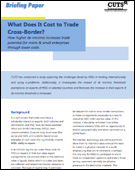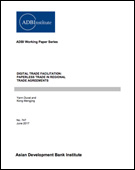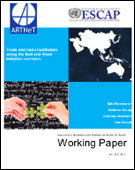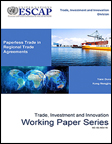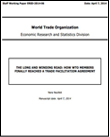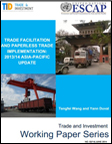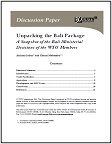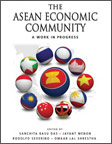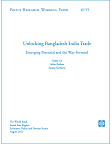Trade Facilitation Results
Trade facilitation focuses on removing barriers to the international movement of goods to lower trade costs, at and around the borders, and along the supply chain, to make countries more competitive in regional and global markets. In the SASEC subregion, bottlenecks in trade facilitation are the leading non-tariff barriers that constrain intraregional trade. SASEC initiatives in trade facilitation aims to make cross-border trade and transport in the subregion faster, cheaper, and more predictable, while maintaining the security of the supply chain and ensuring the effectiveness and efficiency of the institutions involved.
TRANSPORT INDIA
WORKING PAPERS
total items: 10Customs duties, local taxes, and customs clearance increase trade costs and serve as obstacles for many small and medium enterprises. This paper explores challenges these enterprises face in using e-platforms and trading internationally. It looks at de minimis exemptions (the minimum value of goods below which no duties are collected) in India and other economies and analyzes the impact of these exemptions on exports by micro and small enterprises.
Source: Sanjay Kumar Mangla
Most regional trade agreements now feature one or more measures for electronically exchanging trade-related information. These measures are becoming essential to maintaining trade competitiveness and enabling effective participation in cross-border e-commerce. This paper examines the extent to which measures enabling paperless trade are included in regional trade agreements (RTAs), such as the Association of Southeast Asian Nations-India Free Trade Agreement. India leads the region with the highest number of RTAs involving paperless trade measures. Asia-Pacific RTAs now increasingly cover specific areas of paperless trade such as electronic certificates of origin and sanitary and phytosanitary certificates.
Source: Yann Duval and Kong Mengjing
This paper reviews the current state of trade and trade facilitation among the countries along the six corridors under the Belt Road Initiative (BRI), and looks at the potential impact of infrastructure development on trade. It explores at the Bangladesh-China-India-Myanmar (BCIM) corridor, and reviews trade growth, tariff rates, logistics performance index, ease of trading across borders, and other indicators in those countries.
Source: Bala Ramasamy, Matthew Yeung, Chorthip Utoktham, and Yann Duval
This working paper provides a comprehensive list of paperless trade measures in regional trade agreements, which have become more extensive, covering increasingly specific areas including certificate of origins and sanitary and phytosanitary certificates. It also confirms that the number of paperless trade measures have doubled between 2005-2008 and 2013-2016 at the global level, with regional trade containing more provisions than those featured in the World Trade Organization's Trade Facilitation Agreement. It introduces the new United Nations Treaty and Framework Agreement on Cross-Border Paperless Trade in Asia and the Pacific, which aims to become a tool for harmonized implementation of paperless trade provisions.
Source: Yann Duval and Kong Mengjing
The conclusion of the Agreement on Trade Facilitation at the Bali negotiations in December 2013 marked the end of a journey that lasted almost a decade. As the first multilateral trade agreement successfully negotiated by World Trade Organization (WTO) ministers, it broke new ground in the decentralized, bottom-up way the negotiations were structured; in the manner the capacities and resources of developing countries were addressed; and in how the Agreement has shifted the system’s focus beyond policy barriers toward process frictions. The negotiated outcome is likely to have an impact not just on Trade Facilitation, but on the WTO and the multilateral trading system as a whole.
Source: Nora Neufeld
This paper reports survey findings on progress in implementing various trade facilitation and paperless trade measures made by 29 countries in Asia and the Pacific, including six SASEC member countries. Factors considered include pre-arrival clearance, post-clearance audit, National Single Window, and authorized operator programmes. The survey reveals that while countries have prioritized automation and paperless trade at the regional level, there is an urgent need for regional arrangements that will facilitate cross-border exchange of trade-related electronic documents and information to enable smoother trade facilitation.
Source: Tengfei Wang and Yann Duval
The Bali Package represents a key turning point for the World Trade Organization. Covering trade facilitation, agriculture, and trade issues for developing and least-developed countries, it is set to increase trade activity on a global scale and lower the cost of doing international trade. This paper acts as a precursor to its implementation by identifying challenges countries may face, giving a brief history of each pillar, exploring the next possible steps for each ministerial decision, and examining the likely effects of this decision/agreement on various other stakeholders, particularly on consumers.
This paper reports the survey findings that rice value chains are transforming in Bangladesh and India.
Source: Thomas Reardon / Bart Minten / Kevin Z. Chen / Lourdes Adriano
This publication explores the barriers and impediments to the realization of an ASEAN Economic Community (AEC), and to what extent its self-imposed deadline of 2015 for achievement of an AEC is more of a milestone of progress than a firm target. It examines whether the AEC is achievable, the obstacles faced in achieving it, and the measures required to help it become a reality.
Source: Asian Development Bank
This working paper breaks down the importance of trade cooperation between Bangladesh and India by taking a closer look at the impacts of Bangladesh's increased market access to India, and their improved border connectivity. Employing data from national government resources and multilateral development organizations including the International Monetary Fund, World Bank, and World Trade Organization, the study provides an estimate of the trade potential of Bangladesh and India, and calculates the implications on costs of trade facilitation, among others. It also discusses ongoing challenges in bilateral relations and provides recommendations that will enable larger gains for the two contiguous countries.

